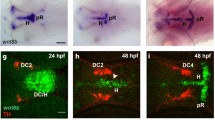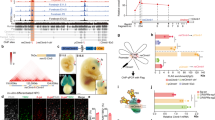Abstract
Development of the telencephalon involves the coordinated growth of diversely patterned brain structures. Previous studies have demonstrated the importance of β-catenin–mediated Wnt signaling in proliferation and fate determination during cerebral cortical development. We found that β-catenin–mediated Wnt signaling critically maintained progenitor proliferation in the subcortical (pallidal) telencephalon. Targeted deletion of β-catenin in mice severely impaired proliferation in the medial ganglionic eminence without grossly altering differentiated fate. Several lines of evidence suggest that this phenotype is primarily the result of a loss of canonical Wnt signaling. As previous studies have suggested that the ventral patterning factor Sonic Hedgehog (Shh) also stimulates dorsal telencephalic proliferation, we propose a model whereby Wnt and Shh signaling promote distinct dorsal-ventral patterning while also having broader effects on proliferation that serve to coordinate the growth of telencephalic subregions.
This is a preview of subscription content, access via your institution
Access options
Subscribe to this journal
Receive 12 print issues and online access
$209.00 per year
only $17.42 per issue
Buy this article
- Purchase on Springer Link
- Instant access to full article PDF
Prices may be subject to local taxes which are calculated during checkout







Similar content being viewed by others
References
Guillemot, F. Cellular and molecular control of neurogenesis in the mammalian telencephalon. Curr. Opin. Cell Biol. 17, 639–647 (2005).
Dahmane, N. et al. The Sonic Hedgehog–Gli pathway regulates dorsal brain growth and tumorigenesis. Development 128, 5201–5212 (2001).
Fuccillo, M., Joyner, A.L. & Fishell, G. Morphogen to mitogen: the multiple roles of hedgehog signaling in vertebrate neural development. Nat. Rev. Neurosci. 7, 772–783 (2006).
Gutin, G. et al. FGF signaling generates ventral telencephalic cells independently of SHH. Development 133, 2937–2946 (2006).
Gregg, C. & Weiss, S. CNTF/LIF/gp130 receptor complex signaling maintains a VZ precursor differentiation gradient in the developing ventral forebrain. Development 132, 565–578 (2005).
Machon, O., van den Bout, C.J., Backman, M., Kemler, R. & Krauss, S. Role of beta-catenin in the developing cortical and hippocampal neuroepithelium. Neuroscience 122, 129–143 (2003).
Chiang, C. et al. Cyclopia and defective axial patterning in mice lacking Sonic hedgehog gene function. Nature 383, 407–413 (1996).
Xu, Q., Wonders, C.P. & Anderson, S.A. Sonic hedgehog maintains the identity of cortical interneuron progenitors in the ventral telencephalon. Development 132, 4987–4998 (2005).
Britto, J., Tannahill, D. & Keynes, R. A critical role for sonic hedgehog signaling in the early expansion of the developing brain. Nat. Neurosci. 5, 103–110 (2002).
Machold, R. et al. Sonic hedgehog is required for progenitor cell maintenance in telencephalic stem cell niches. Neuron 39, 937–950 (2003).
Gulacsi, A. & Lillien, L. Sonic hedgehog and bone morphogenetic protein regulate interneuron development from dorsal telencephalic progenitors in vitro . J. Neurosci. 23, 9862–9872 (2003).
Komada, M. et al. Hedgehog signaling is involved in development of the neocortex. Development 135, 2717–2727 (2008).
Viti, J., Gulacsi, A. & Lillien, L. Wnt regulation of progenitor maturation in the cortex depends on Shh or fibroblast growth factor 2. J. Neurosci. 23, 5919–5927 (2003).
Woodhead, G.J., Mutch, C.A., Olson, E.C. & Chenn, A. Cell-autonomous beta-catenin signaling regulates cortical precursor proliferation. J. Neurosci. 26, 12620–12630 (2006).
Zhou, C.J., Borello, U., Rubenstein, J.L. & Pleasure, S.J. Neuronal production and precursor proliferation defects in the neocortex of mice with loss of function in the canonical Wnt signaling pathway. Neuroscience 142, 1119–1131 (2006).
Behrens, J. et al. Functional interaction of beta-catenin with the transcription factor LEF-1. Nature 382, 638–642 (1996).
Chenn, A. & Walsh, C.A. Regulation of cerebral cortical size by control of cell cycle exit in neural precursors. Science 297, 365–369 (2002).
Zechner, D. et al. beta-Catenin signals regulate cell growth and the balance between progenitor cell expansion and differentiation in the nervous system. Dev. Biol. 258, 406–418 (2003).
Zhou, C.J., Zhao, C. & Pleasure, S.J. Wnt signaling mutants have decreased dentate granule cell production and radial glial scaffolding abnormalities. J. Neurosci. 24, 121–126 (2004).
Backman, M. et al. Effects of canonical Wnt signaling on dorso-ventral specification of the mouse telencephalon. Dev. Biol. 279, 155–168 (2005).
Megason, S.G. & McMahon, A.P. A mitogen gradient of dorsal midline Wnts organizes growth in the CNS. Development 129, 2087–2098 (2002).
Junghans, D., Hack, I., Frotscher, M., Taylor, V. & Kemler, R. Beta-catenin–mediated cell-adhesion is vital for embryonic forebrain development. Dev. Dyn. 233, 528–539 (2005).
Xu, Q., Tam, M. & Anderson, S.A. Fate mapping Nkx2.1-lineage cells in the mouse telencephalon. J. Comp. Neurol. 506, 16–29 (2008).
Brault, V. et al. Inactivation of the beta-catenin gene by Wnt1-Cre–mediated deletion results in dramatic brain malformation and failure of craniofacial development. Development 128, 1253–1264 (2001).
Sussel, L., Marin, O., Kimura, S. & Rubenstein, J.L. Loss of Nkx2.1 homeobox gene function results in a ventral to dorsal molecular respecification within the basal telencephalon: evidence for a transformation of the pallidum into the striatum. Development 126, 3359–3370 (1999).
Marin, O., Anderson, S.A. & Rubenstein, J.L. Origin and molecular specification of striatal interneurons. J. Neurosci. 20, 6063–6076 (2000).
Chenn, A., Zhang, Y.A., Chang, B.T. & McConnell, S.K. Intrinsic polarity of mammalian neuroepithelial cells. Mol. Cell. Neurosci. 11, 183–193 (1998).
Hirabayashi, Y. et al. The Wnt/beta-catenin pathway directs neuronal differentiation of cortical neural precursor cells. Development 131, 2791–2801 (2004).
Solberg, N., Machon, O. & Krauss, S. Effect of canonical Wnt inhibition in the neurogenic cortex, hippocampus, and premigratory dentate gyrus progenitor pool. Dev. Dyn. 237, 1799–1811 (2008).
Lei, Q. et al. Wnt signaling inhibitors regulate the transcriptional response to morphogenetic shh-gli signaling in the neural tube. Dev. Cell 11, 325–337 (2006).
Anderson, S.A., Eisenstat, D.D., Shi, L. & Rubenstein, J.L. Interneuron migration from basal forebrain to neocortex: dependence on Dlx genes. Science 278, 474–476 (1997).
Grigoriou, M., Tucker, A.S., Sharpe, P.T. & Pachnis, V. Expression and regulation of Lhx6 and Lhx7, a novel subfamily of LIM homeodomain encoding genes, suggests a role in mammalian head development. Development 125, 2063–2074 (1998).
Du, T., Xu, Q., Ocbina, P.J. & Anderson, S.A. NKX2.1 specifies cortical interneuron fate by activating Lhx6. Development 135, 1559–1567 (2008).
Wichterle, H., Turnbull, D.H., Nery, S., Fishell, G. & Alvarez-Buylla, A. In utero fate mapping reveals distinct migratory pathways and fates of neurons born in the mammalian basal forebrain. Development 128, 3759–3771 (2001).
Kessaris, N. et al. Competing waves of oligodendrocytes in the forebrain and postnatal elimination of an embryonic lineage. Nat. Neurosci. 9, 173–179 (2006).
Anderson, S.A., Marin, O., Horn, C., Jennings, K. & Rubenstein, J.L. Distinct cortical migrations from the medial and lateral ganglionic eminences. Development 128, 353–363 (2001).
Xu, Q., Cobos, I., De La Cruz, E., Rubenstein, J.L. & Anderson, S.A. Origins of cortical interneuron subtypes. J. Neurosci. 24, 2612–2622 (2004).
Mohamed, O.A., Clarke, H.J. & Dufort, D. Beta-catenin signaling marks the prospective site of primitive streak formation in the mouse embryo. Dev. Dyn. 231, 416–424 (2004).
Hsieh, J.C., Rattner, A., Smallwood, P.M. & Nathans, J. Biochemical characterization of Wnt-frizzled interactions using a soluble, biologically active vertebrate Wnt protein. Proc. Natl. Acad. Sci. USA 96, 3546–3551 (1999).
Grove, E.A., Tole, S., Limon, J., Yip, L. & Ragsdale, C.W. The hem of the embryonic cerebral cortex is defined by the expression of multiple Wnt genes and is compromised in Gli3-deficient mice. Development 125, 2315–2325 (1998).
Parr, B.A. & McMahon, A.P. Dorsalizing signal Wnt-7a required for normal polarity of D-V and A-P axes of mouse limb. Nature 374, 350–353 (1995).
Shu, W., Jiang, Y.Q., Lu, M.M. & Morrisey, E.E. Wnt7b regulates mesenchymal proliferation and vascular development in the lung. Development 129, 4831–4842 (2002).
Lien, W.H., Klezovitch, O., Fernandez, T.E., Delrow, J. & Vasioukhin, V. αE-catenin controls cerebral cortical size by regulating the hedgehog signaling pathway. Science 311, 1609–1612 (2006).
Kadowaki, M. et al. N-cadherin mediates cortical organization in the mouse brain. Dev. Biol. 304, 22–33 (2007).
Rasin, M.R. et al. Numb and Numbl are required for maintenance of cadherin-based adhesion and polarity of neural progenitors. Nat. Neurosci. 10, 819–827 (2007).
Klezovitch, O., Fernandez, T.E., Tapscott, S.J. & Vasioukhin, V. Loss of cell polarity causes severe brain dysplasia in Lgl1 knockout mice. Genes Dev 18, 559–571 (2004).
Huangfu, D. et al. Hedgehog signaling in the mouse requires intraflagellar transport proteins. Nature 426, 83–87 (2003).
Stenman, J., Toresson, H. & Campbell, K. Identification of two distinct progenitor populations in the lateral ganglionic eminence: implications for striatal and olfactory bulb neurogenesis. J. Neurosci. 23, 167–174 (2003).
Acknowledgements
We thank M.P. Matise for helpful discussions and Q. Xu (Nkx2.1Cre), D. Dufort (Tcf-LacZ), R. Kemler (β-catenin Jackson Laboratory), K. Campbell (Dlx5/6Cre) and E. Morrisey (Wnt7b-lacZ embryos) for providing mice. We thank M.P. Matise (Tcf4 riboprobe), O. Marin (Nkx5.1 riboprobe) and S. Pleasure (drLef1-gfp construct) for probes and reagents. We also thank S. LoCurto for her technical assistance. This work was supported by research grants to S.A.A. from the US National Institutes of Health (P01 NS048120 and K02MH070031).
Author information
Authors and Affiliations
Contributions
A.A.G. and S.A.A. designed the experiments; A.A.G. carried out the experiments and analyzed the data; and A.A.G. and S.A.A. wrote the paper.
Corresponding author
Supplementary information
Supplementary Text and Figures
Supplementary Figures 1–6 and Supplementary Table 1 (PDF 4271 kb)
Rights and permissions
About this article
Cite this article
Gulacsi, A., Anderson, S. β-catenin–mediated Wnt signaling regulates neurogenesis in the ventral telencephalon. Nat Neurosci 11, 1383–1391 (2008). https://doi.org/10.1038/nn.2226
Received:
Accepted:
Published:
Issue Date:
DOI: https://doi.org/10.1038/nn.2226
This article is cited by
-
β-Catenin Deletion in Regional Neural Progenitors Leads to Congenital Hydrocephalus in Mice
Neuroscience Bulletin (2022)
-
Differential roles of ARID1B in excitatory and inhibitory neural progenitors in the developing cortex
Scientific Reports (2021)
-
Thyroid hormone influences brain gene expression programs and behaviors in later generations by altering germ line epigenetic information
Molecular Psychiatry (2020)
-
PCDHGA9 represses epithelial-mesenchymal transition and metastatic potential in gastric cancer cells by reducing β-catenin transcriptional activity
Cell Death & Disease (2020)
-
Developmental protein kinase C hyper-activation results in microcephaly and behavioral abnormalities in zebrafish
Translational Psychiatry (2018)



